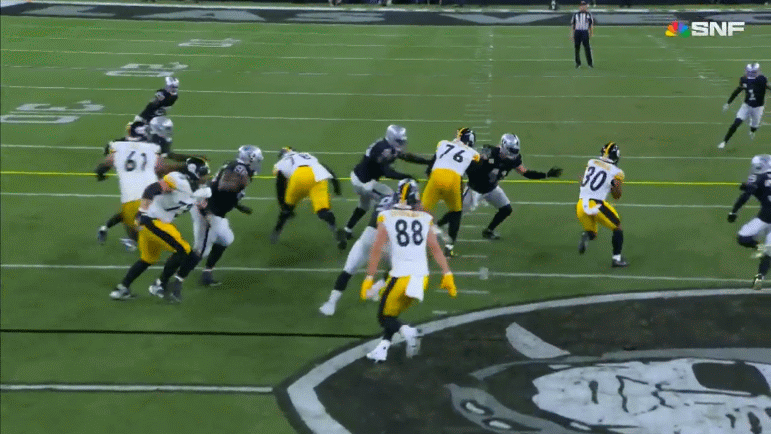The Steelers’ run game has been under the spotlight, seeking that extra gear for awhile now. And with every week, discussions spark about what could be the next tweak to rejuvenate the Steelers’ approach. While Matt Canada, the offensive coordinator, has his signature touch of pre-snap motion, there’s a fresh wave across the league that he’s yet to tap into – and it could be a nice bullet to add to the chamber.
That trend? Motioning the tight end on a pre-snap jet sweep-like, especially on split-zone and duo runs.
Now, let’s be clear: I’m not hopping onto this bandwagon just because every Tom, Dick, and Harry in the NFL is doing it. No, my advocacy was born out of concern. Specifically, a concern about how slow the Steelers’ tight ends have been getting across the formation on similar runs.
Let’s take a look first at the most egregious example from Week Four.
The 6-foot-7, 264-pound rookie Darnell Washington wasn’t drafted for his nimbleness. Add in the fact that he’s also a hair late off the snap here and you see the issues it can create in the backfield. He’s not remotely able to get across the formation to block the free backside rusher and almost takes out Najee Harris himself.
Luckily, Harris is able to create something out of nothing here and get a nice gain.
Throughout that game, this split-zone flow from the tight end was a regular speed bump for Harris.
Many plays are meticulously designed, mapping out players’ each and every step, ensuring they hit their specific destinations or “landmarks.” When executed correctly, it’s seamless. However, it’s concerning to see Harris frequently forced to adjust off the pace of his tight ends, causing him to momentarily halt his momentum, as evident in the numerous clips below.
The slight hesitation is noticeable, making Harris decelerate.
This doesn’t just obstruct his field vision; it also hampers his decision-making. Typically, on an inside zone play, running backs have a three-way go. Here, Harris’s choices are limited to two as he’s unable to cut back behind a blocker who has just crossed his face.
You also see Connor Heyward and Washington struggle to get to their spots in time, compromising their angle against the oncoming backside edge defender.
Implementing the motion pre-snap is a win-win for everyone:
- The running back gains a clearer sight line of the evolving gaps up ahead, minus the clutter.
- With an unobstructed path, the running back has a wide-open runway to get downhill if a hole is there.
- The tight end benefits too, reaching his intended spot more promptly. That in turn puts pressure on the backside EDGEs by giving them a shorter reaction window.
To add a cherry on top, integrating this can be a game-changer in play-action scenarios. With it, the tight end secures a clearer path for himself, seamlessly moving out into the flat. This eliminates the hassle of dodging any potential disruptions in the backfield when he’s maneuvering past the midline post-snap.
This wasn’t just a Week Four problem either. Remember the 3rd-and-1 call everyone hated in the Week Two game vs. Cleveland?
It had the same issue with the tight end being late across the line of scrimmage and really ruined the play in itself. Now, I know there’s already a pre-snap motion here with George Pickens faking the jet sweep, but that’s pretty useless in the grand scheme here and could be eliminated.
Imagine if Washington was in motion before the snap. He’d likely already be past that overpursuing EDGE (No. 54) — Pickett’s read on this play. He’d then be set to take on the Browns’ No. 5, the eventual playmaker. Instead, Washington finds himself blocking a defender, who’s already lost containment, back into the play resulting in a dead-end for Pickett.
Is this the magic wand that turns the Steelers’ season around? Doubtful.
But let’s not sleep on the potential benefits. Optimizing parts of the playbook isn’t just for show, it’s about getting everyone, especially those who might not boast top-tier athleticism, in spots where they can win more easily and efficiently. It’s these nuanced changes that, frustratingly, we’re not consistently seeing from Matt Canada. Let’s remember: the league’s top coordinators are incorporating these strategies for a reason. It’s high time the Steelers get with the program.








